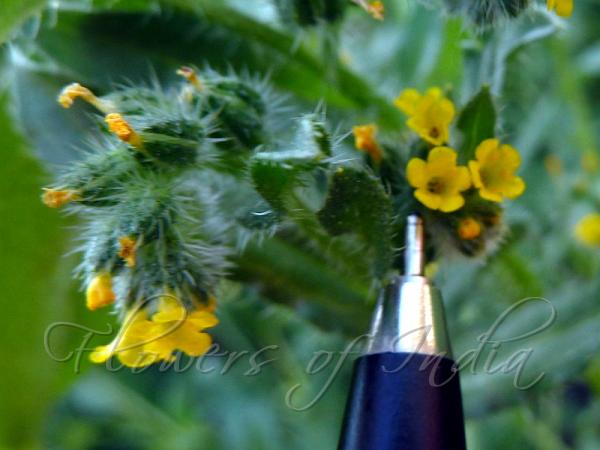|
| Arabian Primrose |
|

|

| File size | 188683 |
| Original date | 6/14/14 5:01 PM |
| Resolution | 2560 x 1920 |
| Flash | Flash did not fire, auto |
| Focal length | 4.1mm |
| Exposure time | 1/30s |
| Aperture | 3.3 |
| Focus Distance | |
| Metering Mode | Multi-segment |
| Camera make | Panasonic |
| Camera model | DMC-TZ10 |
| Sensor type | OneChipColorArea |
|
|
|
|
Photo: |
Botanical name: Arnebia hispidissima Family: Boraginaceae (Forget-me-not family)
Synonyms: Arnebia lutea, Arnebia asperrima, Anchusa hispidissima
Synonyms: Arnebia lutea, Arnebia asperrima, Anchusa hispidissima
Arabian Primrose is an annual herb up to 40 cm
tall, erect or ascending, much branched from the base, with strong red
roots, densely covered with white bristles. Leaves are alternate,
simple, without stipules, stalkless; blade linear-lanceshaped, 1.58 cm
x 0.2-1 cm, tip pointed to blunt, margin entire. Inflorescence
spike-like, consisting of at branch-ends, short and dense scorpioid
cymes, simple or forked; bracts leaf-like. Flowers are stalkless,
bisexual, regular, 5-merous; calyx deeply divided, sepals 5-8 mm long,
unequal, hardly accrescent in fruit. Flower are tubular, 8-16 mm long,
yellow, tube hairy inside, petals small; stamens inserted at about the
middle of the flower tube, filaments about 0.5 mm long, anthers 1.5 mm;
ovary superior, 4-lobed, style about 1 cm long, 2-lobed, each lobe
ending in a kidney-shaped stigma. Fruit consists of 4 pyramidal nutlets
up to 2 mm long, ventrally keeled, granulose to smooth, grey to
yellow-brown. Arabian Primrose is found in tropical Africa, Egypt, to
India.
Medicinal uses: In Indian traditional medicine
root extracts are used to treat ulcers, boils, cuts, throat complaints,
heart problems, headache and fever
In Indian traditional medicine
root extracts are used to treat ulcers, boils, cuts, throat complaints,
heart problems, headache and fever
Medicinal uses:
 In Indian traditional medicine
root extracts are used to treat ulcers, boils, cuts, throat complaints,
heart problems, headache and fever
In Indian traditional medicine
root extracts are used to treat ulcers, boils, cuts, throat complaints,
heart problems, headache and fever | Identification credit: Tabish, Priyanka Salunkhe | Photographed in Lahaul, Himachal Pradesh & Yamunanagar, Haryana. |
• Is this flower misidentified? If yes,